SMEs in the UK: Start-up Processes, Competitive Advantage, and Growth
VerifiedAdded on 2023/04/22
|15
|3822
|113
Report
AI Summary
This report provides an analysis of Small and Medium-sized Enterprises (SMEs) in the UK, focusing on their contribution to economic growth and development. It explores the nature of entrepreneurs behind ventures like Chic by Choice, an e-commerce firm specializing in luxury dress rentals. The report details the SME start-up processes, including market research, business planning, financial planning, and choosing a suitable business format. It examines the business concept, sources of competitive advantage, current demand levels, and competitive environment. Furthermore, the report discusses the challenges faced by SMEs, such as stiff market competition and limited capital resources, and explores current growth and development strategies, as well as potential government support measures. The analysis concludes with recommendations for SMEs to overcome challenges and enhance their growth prospects.

Running head: SMEs IN THE UK
SMEs in the UK
Name of the Student:
Name of the University:
Author Note:
SMEs in the UK
Name of the Student:
Name of the University:
Author Note:
Paraphrase This Document
Need a fresh take? Get an instant paraphrase of this document with our AI Paraphraser

1
SMEs IN THE UK
Table of Contents
Introduction:....................................................................................................................................3
Findings:..........................................................................................................................................4
The nature of the entrepreneur behind the venture:.........................................................................4
The SME start-up processes:...........................................................................................................4
Step 1: Market research:..............................................................................................................5
Step 2. Planning the business:.....................................................................................................5
Step 3. Financial planning:..............................................................................................................6
Step 4: Choosing an appropriate business format:......................................................................6
Step 5: Deciding and registration of business name:...................................................................7
Step 6: Obtaining licenses and permit:............................................................................................7
Step 7: Accounting system:.............................................................................................................7
Step 8. Business location and manpower:...................................................................................7
The business concept and any sources of competitive advantage:..................................................7
The current level of demand and the competitive environment:.....................................................8
The growth and development of the business to date:.....................................................................8
The challenges of managing and running the business:..................................................................8
Stiff market competition:.............................................................................................................8
Limited capital resources:............................................................................................................9
The SMEs current growth and development strategy:..................................................................10
SMEs IN THE UK
Table of Contents
Introduction:....................................................................................................................................3
Findings:..........................................................................................................................................4
The nature of the entrepreneur behind the venture:.........................................................................4
The SME start-up processes:...........................................................................................................4
Step 1: Market research:..............................................................................................................5
Step 2. Planning the business:.....................................................................................................5
Step 3. Financial planning:..............................................................................................................6
Step 4: Choosing an appropriate business format:......................................................................6
Step 5: Deciding and registration of business name:...................................................................7
Step 6: Obtaining licenses and permit:............................................................................................7
Step 7: Accounting system:.............................................................................................................7
Step 8. Business location and manpower:...................................................................................7
The business concept and any sources of competitive advantage:..................................................7
The current level of demand and the competitive environment:.....................................................8
The growth and development of the business to date:.....................................................................8
The challenges of managing and running the business:..................................................................8
Stiff market competition:.............................................................................................................8
Limited capital resources:............................................................................................................9
The SMEs current growth and development strategy:..................................................................10

2
SMEs IN THE UK
Any government support measures that may be available to help the business overcome the
challenges faced:............................................................................................................................10
Conclusion:....................................................................................................................................11
Recommendations:....................................................................................................................11
References:....................................................................................................................................12
SMEs IN THE UK
Any government support measures that may be available to help the business overcome the
challenges faced:............................................................................................................................10
Conclusion:....................................................................................................................................11
Recommendations:....................................................................................................................11
References:....................................................................................................................................12
⊘ This is a preview!⊘
Do you want full access?
Subscribe today to unlock all pages.

Trusted by 1+ million students worldwide
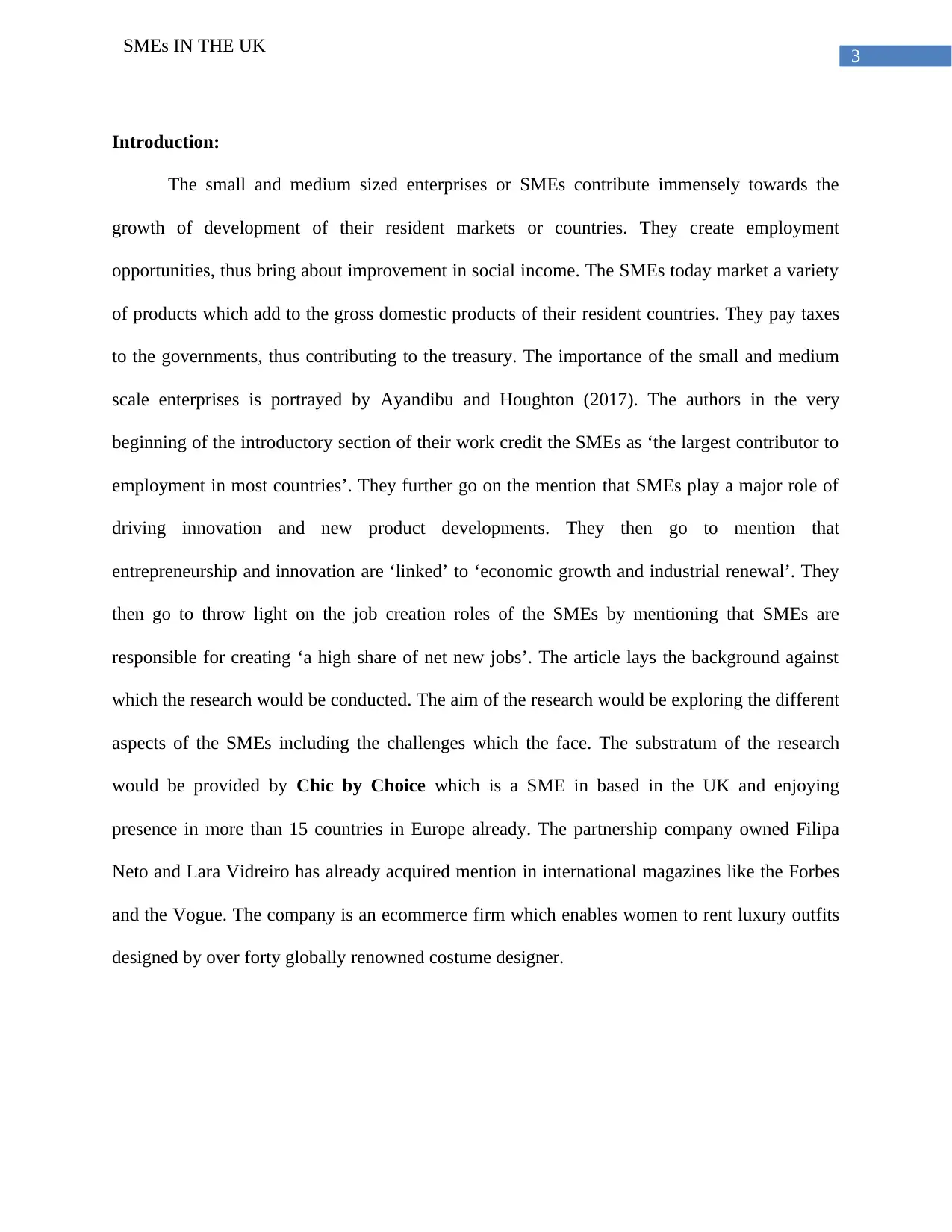
3
SMEs IN THE UK
Introduction:
The small and medium sized enterprises or SMEs contribute immensely towards the
growth of development of their resident markets or countries. They create employment
opportunities, thus bring about improvement in social income. The SMEs today market a variety
of products which add to the gross domestic products of their resident countries. They pay taxes
to the governments, thus contributing to the treasury. The importance of the small and medium
scale enterprises is portrayed by Ayandibu and Houghton (2017). The authors in the very
beginning of the introductory section of their work credit the SMEs as ‘the largest contributor to
employment in most countries’. They further go on the mention that SMEs play a major role of
driving innovation and new product developments. They then go to mention that
entrepreneurship and innovation are ‘linked’ to ‘economic growth and industrial renewal’. They
then go to throw light on the job creation roles of the SMEs by mentioning that SMEs are
responsible for creating ‘a high share of net new jobs’. The article lays the background against
which the research would be conducted. The aim of the research would be exploring the different
aspects of the SMEs including the challenges which the face. The substratum of the research
would be provided by Chic by Choice which is a SME in based in the UK and enjoying
presence in more than 15 countries in Europe already. The partnership company owned Filipa
Neto and Lara Vidreiro has already acquired mention in international magazines like the Forbes
and the Vogue. The company is an ecommerce firm which enables women to rent luxury outfits
designed by over forty globally renowned costume designer.
SMEs IN THE UK
Introduction:
The small and medium sized enterprises or SMEs contribute immensely towards the
growth of development of their resident markets or countries. They create employment
opportunities, thus bring about improvement in social income. The SMEs today market a variety
of products which add to the gross domestic products of their resident countries. They pay taxes
to the governments, thus contributing to the treasury. The importance of the small and medium
scale enterprises is portrayed by Ayandibu and Houghton (2017). The authors in the very
beginning of the introductory section of their work credit the SMEs as ‘the largest contributor to
employment in most countries’. They further go on the mention that SMEs play a major role of
driving innovation and new product developments. They then go to mention that
entrepreneurship and innovation are ‘linked’ to ‘economic growth and industrial renewal’. They
then go to throw light on the job creation roles of the SMEs by mentioning that SMEs are
responsible for creating ‘a high share of net new jobs’. The article lays the background against
which the research would be conducted. The aim of the research would be exploring the different
aspects of the SMEs including the challenges which the face. The substratum of the research
would be provided by Chic by Choice which is a SME in based in the UK and enjoying
presence in more than 15 countries in Europe already. The partnership company owned Filipa
Neto and Lara Vidreiro has already acquired mention in international magazines like the Forbes
and the Vogue. The company is an ecommerce firm which enables women to rent luxury outfits
designed by over forty globally renowned costume designer.
Paraphrase This Document
Need a fresh take? Get an instant paraphrase of this document with our AI Paraphraser

4
SMEs IN THE UK
Findings:
The nature of the entrepreneur behind the venture:
As mentioned in the Forbes magazine, the founders of Chic by Choice founded the
entrepreneurial venture because they were innovative by nature. The magazine mentions that the
founders and owners of the SME could not find suitable dresses for a certain event which was
revealed in an interview of Neto, one of the founders (Forbes.com. 2019). They recognized this
lack of suitable luxury dresses within affordable prices in the UK. They viewed this gap in the
British market as an opportunity to launch a business firm which allows women to rent dresses
once worn by catwalk models. The official website of the company mentions the catch line
which reads ‘Devastatingly, Chic by Choice’. This phrase reveal another salient aspect of the
nature of the entrepreneurs Filipa Neto and Lara Vidreiro which is customer centric operations
(Forbes.com. 2019). The term ‘devastating’ can be interpreted as the reflection of the level of
confidence and satisfaction which the female consumers of the company would experience on
wearing the dresses from the online dress rental company. Nada and Ali (2015) point out that
SMEs create value for the customers by providing innovative products. The confidence and
satisfaction which the women feel on wearing dresses from Chic by Choice can be interpreted as
value to them which the company creates. It can be pointed out that the next aspect of the nature
of the entrepreneurs which encouraged to launch the venture is customer value creation motive.
The SME start-up processes:
Starting new business ventures requires several processes to be followed. The following
are the steps which entrepreneurs have to go through in order launch their start up business:
SMEs IN THE UK
Findings:
The nature of the entrepreneur behind the venture:
As mentioned in the Forbes magazine, the founders of Chic by Choice founded the
entrepreneurial venture because they were innovative by nature. The magazine mentions that the
founders and owners of the SME could not find suitable dresses for a certain event which was
revealed in an interview of Neto, one of the founders (Forbes.com. 2019). They recognized this
lack of suitable luxury dresses within affordable prices in the UK. They viewed this gap in the
British market as an opportunity to launch a business firm which allows women to rent dresses
once worn by catwalk models. The official website of the company mentions the catch line
which reads ‘Devastatingly, Chic by Choice’. This phrase reveal another salient aspect of the
nature of the entrepreneurs Filipa Neto and Lara Vidreiro which is customer centric operations
(Forbes.com. 2019). The term ‘devastating’ can be interpreted as the reflection of the level of
confidence and satisfaction which the female consumers of the company would experience on
wearing the dresses from the online dress rental company. Nada and Ali (2015) point out that
SMEs create value for the customers by providing innovative products. The confidence and
satisfaction which the women feel on wearing dresses from Chic by Choice can be interpreted as
value to them which the company creates. It can be pointed out that the next aspect of the nature
of the entrepreneurs which encouraged to launch the venture is customer value creation motive.
The SME start-up processes:
Starting new business ventures requires several processes to be followed. The following
are the steps which entrepreneurs have to go through in order launch their start up business:
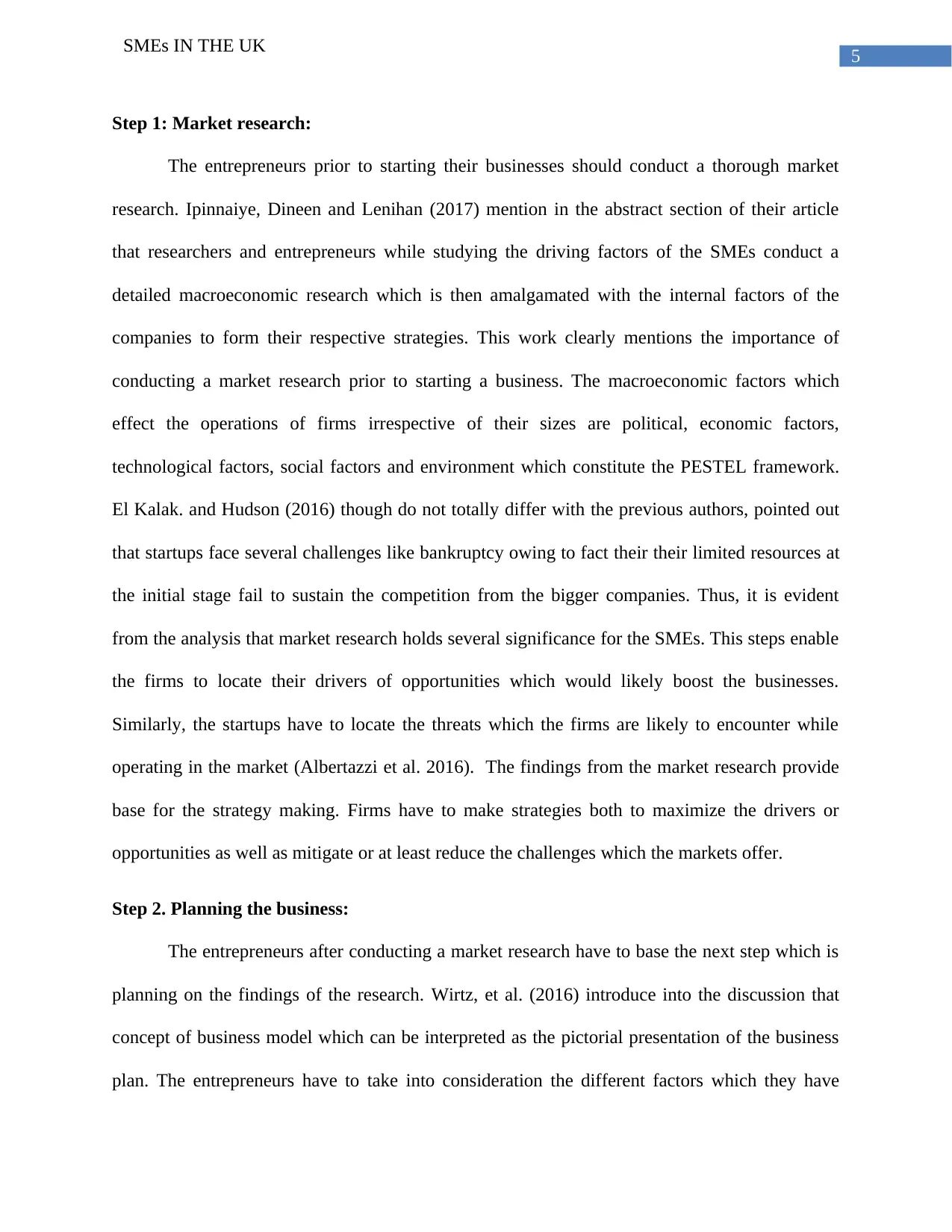
5
SMEs IN THE UK
Step 1: Market research:
The entrepreneurs prior to starting their businesses should conduct a thorough market
research. Ipinnaiye, Dineen and Lenihan (2017) mention in the abstract section of their article
that researchers and entrepreneurs while studying the driving factors of the SMEs conduct a
detailed macroeconomic research which is then amalgamated with the internal factors of the
companies to form their respective strategies. This work clearly mentions the importance of
conducting a market research prior to starting a business. The macroeconomic factors which
effect the operations of firms irrespective of their sizes are political, economic factors,
technological factors, social factors and environment which constitute the PESTEL framework.
El Kalak. and Hudson (2016) though do not totally differ with the previous authors, pointed out
that startups face several challenges like bankruptcy owing to fact their their limited resources at
the initial stage fail to sustain the competition from the bigger companies. Thus, it is evident
from the analysis that market research holds several significance for the SMEs. This steps enable
the firms to locate their drivers of opportunities which would likely boost the businesses.
Similarly, the startups have to locate the threats which the firms are likely to encounter while
operating in the market (Albertazzi et al. 2016). The findings from the market research provide
base for the strategy making. Firms have to make strategies both to maximize the drivers or
opportunities as well as mitigate or at least reduce the challenges which the markets offer.
Step 2. Planning the business:
The entrepreneurs after conducting a market research have to base the next step which is
planning on the findings of the research. Wirtz, et al. (2016) introduce into the discussion that
concept of business model which can be interpreted as the pictorial presentation of the business
plan. The entrepreneurs have to take into consideration the different factors which they have
SMEs IN THE UK
Step 1: Market research:
The entrepreneurs prior to starting their businesses should conduct a thorough market
research. Ipinnaiye, Dineen and Lenihan (2017) mention in the abstract section of their article
that researchers and entrepreneurs while studying the driving factors of the SMEs conduct a
detailed macroeconomic research which is then amalgamated with the internal factors of the
companies to form their respective strategies. This work clearly mentions the importance of
conducting a market research prior to starting a business. The macroeconomic factors which
effect the operations of firms irrespective of their sizes are political, economic factors,
technological factors, social factors and environment which constitute the PESTEL framework.
El Kalak. and Hudson (2016) though do not totally differ with the previous authors, pointed out
that startups face several challenges like bankruptcy owing to fact their their limited resources at
the initial stage fail to sustain the competition from the bigger companies. Thus, it is evident
from the analysis that market research holds several significance for the SMEs. This steps enable
the firms to locate their drivers of opportunities which would likely boost the businesses.
Similarly, the startups have to locate the threats which the firms are likely to encounter while
operating in the market (Albertazzi et al. 2016). The findings from the market research provide
base for the strategy making. Firms have to make strategies both to maximize the drivers or
opportunities as well as mitigate or at least reduce the challenges which the markets offer.
Step 2. Planning the business:
The entrepreneurs after conducting a market research have to base the next step which is
planning on the findings of the research. Wirtz, et al. (2016) introduce into the discussion that
concept of business model which can be interpreted as the pictorial presentation of the business
plan. The entrepreneurs have to take into consideration the different factors which they have
⊘ This is a preview!⊘
Do you want full access?
Subscribe today to unlock all pages.

Trusted by 1+ million students worldwide
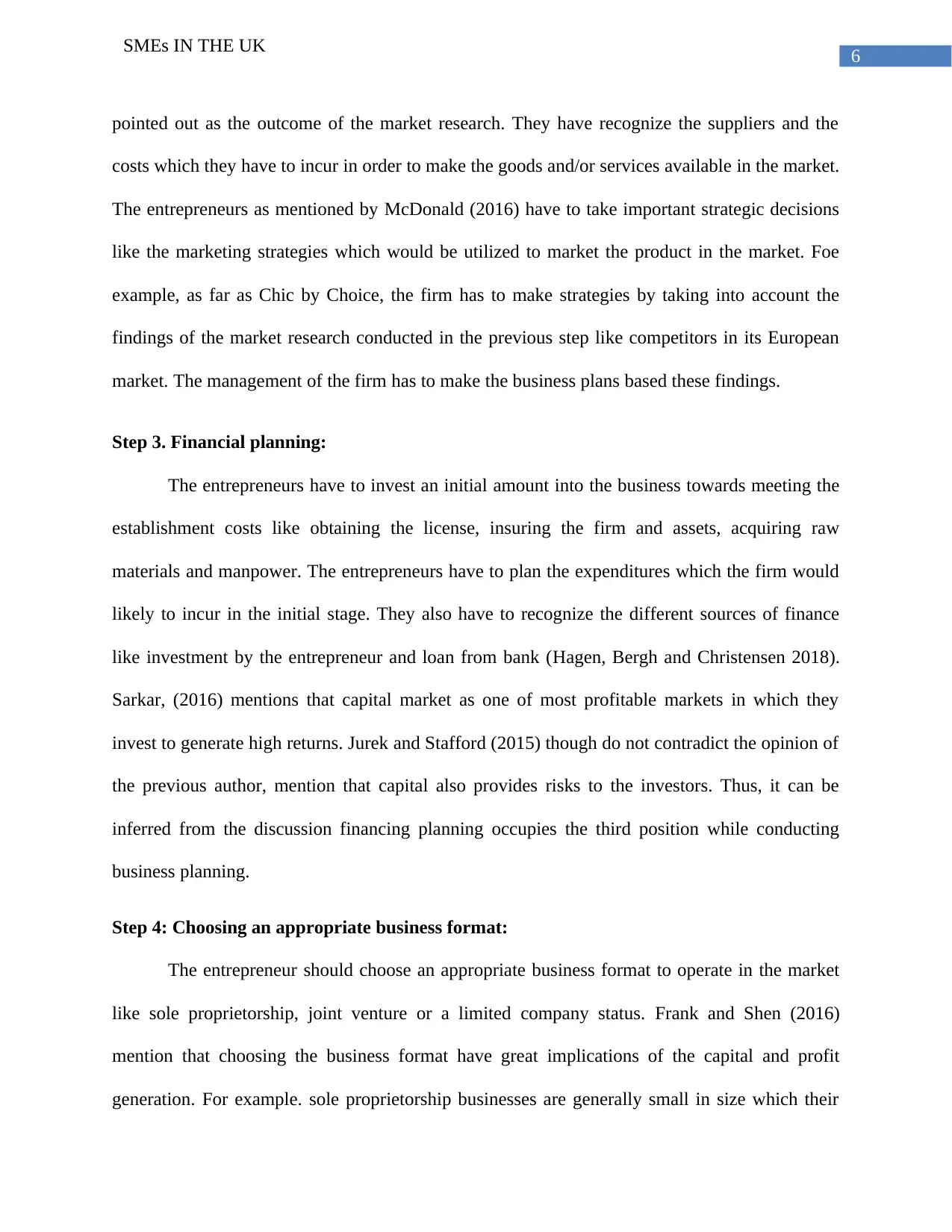
6
SMEs IN THE UK
pointed out as the outcome of the market research. They have recognize the suppliers and the
costs which they have to incur in order to make the goods and/or services available in the market.
The entrepreneurs as mentioned by McDonald (2016) have to take important strategic decisions
like the marketing strategies which would be utilized to market the product in the market. Foe
example, as far as Chic by Choice, the firm has to make strategies by taking into account the
findings of the market research conducted in the previous step like competitors in its European
market. The management of the firm has to make the business plans based these findings.
Step 3. Financial planning:
The entrepreneurs have to invest an initial amount into the business towards meeting the
establishment costs like obtaining the license, insuring the firm and assets, acquiring raw
materials and manpower. The entrepreneurs have to plan the expenditures which the firm would
likely to incur in the initial stage. They also have to recognize the different sources of finance
like investment by the entrepreneur and loan from bank (Hagen, Bergh and Christensen 2018).
Sarkar, (2016) mentions that capital market as one of most profitable markets in which they
invest to generate high returns. Jurek and Stafford (2015) though do not contradict the opinion of
the previous author, mention that capital also provides risks to the investors. Thus, it can be
inferred from the discussion financing planning occupies the third position while conducting
business planning.
Step 4: Choosing an appropriate business format:
The entrepreneur should choose an appropriate business format to operate in the market
like sole proprietorship, joint venture or a limited company status. Frank and Shen (2016)
mention that choosing the business format have great implications of the capital and profit
generation. For example. sole proprietorship businesses are generally small in size which their
SMEs IN THE UK
pointed out as the outcome of the market research. They have recognize the suppliers and the
costs which they have to incur in order to make the goods and/or services available in the market.
The entrepreneurs as mentioned by McDonald (2016) have to take important strategic decisions
like the marketing strategies which would be utilized to market the product in the market. Foe
example, as far as Chic by Choice, the firm has to make strategies by taking into account the
findings of the market research conducted in the previous step like competitors in its European
market. The management of the firm has to make the business plans based these findings.
Step 3. Financial planning:
The entrepreneurs have to invest an initial amount into the business towards meeting the
establishment costs like obtaining the license, insuring the firm and assets, acquiring raw
materials and manpower. The entrepreneurs have to plan the expenditures which the firm would
likely to incur in the initial stage. They also have to recognize the different sources of finance
like investment by the entrepreneur and loan from bank (Hagen, Bergh and Christensen 2018).
Sarkar, (2016) mentions that capital market as one of most profitable markets in which they
invest to generate high returns. Jurek and Stafford (2015) though do not contradict the opinion of
the previous author, mention that capital also provides risks to the investors. Thus, it can be
inferred from the discussion financing planning occupies the third position while conducting
business planning.
Step 4: Choosing an appropriate business format:
The entrepreneur should choose an appropriate business format to operate in the market
like sole proprietorship, joint venture or a limited company status. Frank and Shen (2016)
mention that choosing the business format have great implications of the capital and profit
generation. For example. sole proprietorship businesses are generally small in size which their
Paraphrase This Document
Need a fresh take? Get an instant paraphrase of this document with our AI Paraphraser

7
SMEs IN THE UK
initial investment coming from the owner. Again, partnership companies like Chic by Choice
attract resources from the owners, thus accumulating larger amount of capital.
Step 5: Deciding and registration of business name:
The owners should go decide a name and register their companies with the relevant
authority. For example, Chic by Choice being a British company would get accept a name and
register it in the UK. The name of the businesses are supposed to appear on documents issued by
the company and in the premises of the company.
Step 6: Obtaining licenses and permit:
The sixth step which startup processes follow should be obtaining licenses and permit.
The management of the company should have the licenses and permits to start the businesses,
Step 7: Accounting system:
The entrepreneurial venture should choose its accounting system to be followed in order
to calculate the profits and losses by the government. The companies should appoint skillful
accounting professionals to record and analyze the financial transactions.
Step 8. Business location and manpower:
The entrepreneur should recognize the location where the business would be located and
the manpower which the company would employ.
The business concept and any sources of competitive advantage:
The start-up provide new products to consumers at lower prices which provide them the
competitive advantage compared to their competing. Tanev (2017) points out that new product
concept of the start-up and their innovative products offer them competitive advantages over
their competitors.
SMEs IN THE UK
initial investment coming from the owner. Again, partnership companies like Chic by Choice
attract resources from the owners, thus accumulating larger amount of capital.
Step 5: Deciding and registration of business name:
The owners should go decide a name and register their companies with the relevant
authority. For example, Chic by Choice being a British company would get accept a name and
register it in the UK. The name of the businesses are supposed to appear on documents issued by
the company and in the premises of the company.
Step 6: Obtaining licenses and permit:
The sixth step which startup processes follow should be obtaining licenses and permit.
The management of the company should have the licenses and permits to start the businesses,
Step 7: Accounting system:
The entrepreneurial venture should choose its accounting system to be followed in order
to calculate the profits and losses by the government. The companies should appoint skillful
accounting professionals to record and analyze the financial transactions.
Step 8. Business location and manpower:
The entrepreneur should recognize the location where the business would be located and
the manpower which the company would employ.
The business concept and any sources of competitive advantage:
The start-up provide new products to consumers at lower prices which provide them the
competitive advantage compared to their competing. Tanev (2017) points out that new product
concept of the start-up and their innovative products offer them competitive advantages over
their competitors.
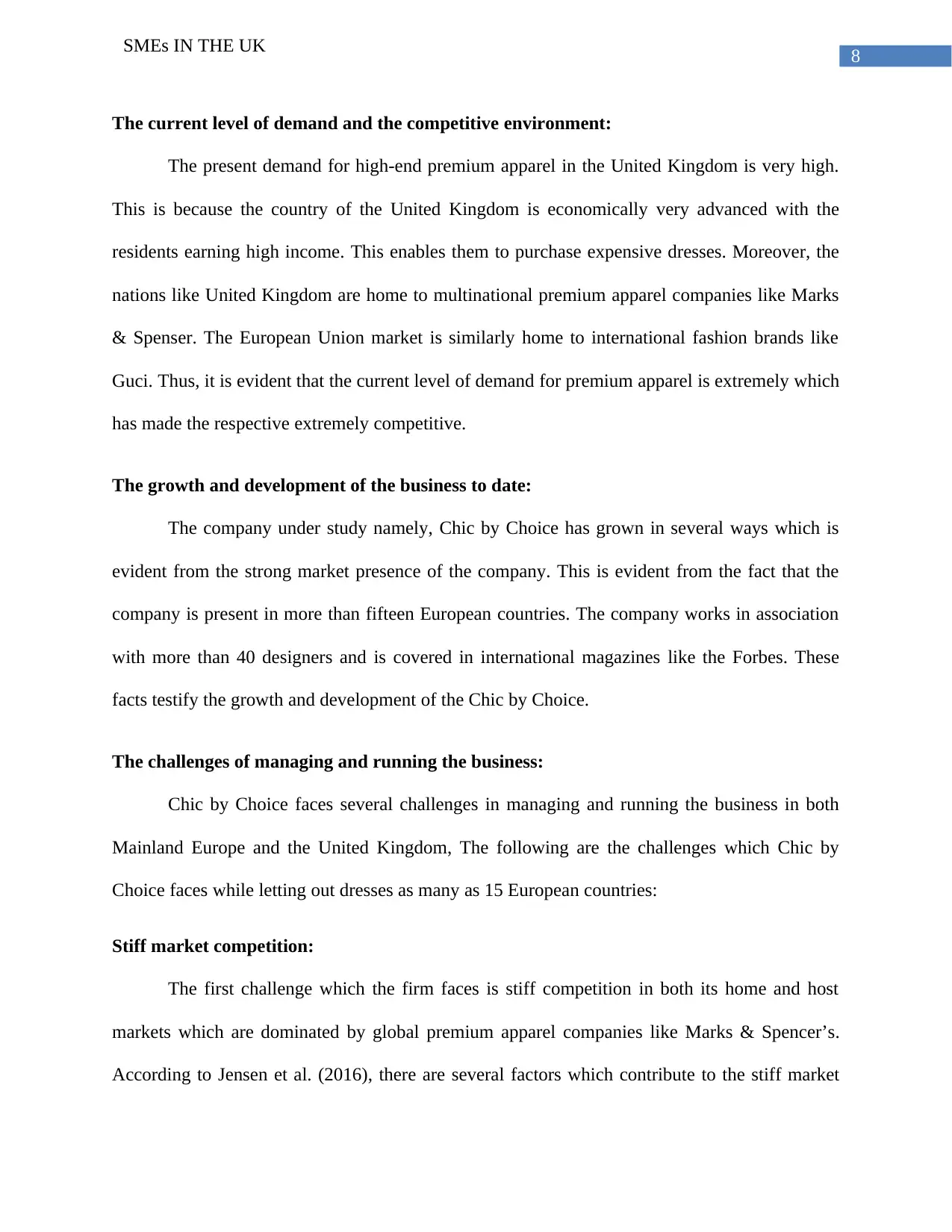
8
SMEs IN THE UK
The current level of demand and the competitive environment:
The present demand for high-end premium apparel in the United Kingdom is very high.
This is because the country of the United Kingdom is economically very advanced with the
residents earning high income. This enables them to purchase expensive dresses. Moreover, the
nations like United Kingdom are home to multinational premium apparel companies like Marks
& Spenser. The European Union market is similarly home to international fashion brands like
Guci. Thus, it is evident that the current level of demand for premium apparel is extremely which
has made the respective extremely competitive.
The growth and development of the business to date:
The company under study namely, Chic by Choice has grown in several ways which is
evident from the strong market presence of the company. This is evident from the fact that the
company is present in more than fifteen European countries. The company works in association
with more than 40 designers and is covered in international magazines like the Forbes. These
facts testify the growth and development of the Chic by Choice.
The challenges of managing and running the business:
Chic by Choice faces several challenges in managing and running the business in both
Mainland Europe and the United Kingdom, The following are the challenges which Chic by
Choice faces while letting out dresses as many as 15 European countries:
Stiff market competition:
The first challenge which the firm faces is stiff competition in both its home and host
markets which are dominated by global premium apparel companies like Marks & Spencer’s.
According to Jensen et al. (2016), there are several factors which contribute to the stiff market
SMEs IN THE UK
The current level of demand and the competitive environment:
The present demand for high-end premium apparel in the United Kingdom is very high.
This is because the country of the United Kingdom is economically very advanced with the
residents earning high income. This enables them to purchase expensive dresses. Moreover, the
nations like United Kingdom are home to multinational premium apparel companies like Marks
& Spenser. The European Union market is similarly home to international fashion brands like
Guci. Thus, it is evident that the current level of demand for premium apparel is extremely which
has made the respective extremely competitive.
The growth and development of the business to date:
The company under study namely, Chic by Choice has grown in several ways which is
evident from the strong market presence of the company. This is evident from the fact that the
company is present in more than fifteen European countries. The company works in association
with more than 40 designers and is covered in international magazines like the Forbes. These
facts testify the growth and development of the Chic by Choice.
The challenges of managing and running the business:
Chic by Choice faces several challenges in managing and running the business in both
Mainland Europe and the United Kingdom, The following are the challenges which Chic by
Choice faces while letting out dresses as many as 15 European countries:
Stiff market competition:
The first challenge which the firm faces is stiff competition in both its home and host
markets which are dominated by global premium apparel companies like Marks & Spencer’s.
According to Jensen et al. (2016), there are several factors which contribute to the stiff market
⊘ This is a preview!⊘
Do you want full access?
Subscribe today to unlock all pages.

Trusted by 1+ million students worldwide
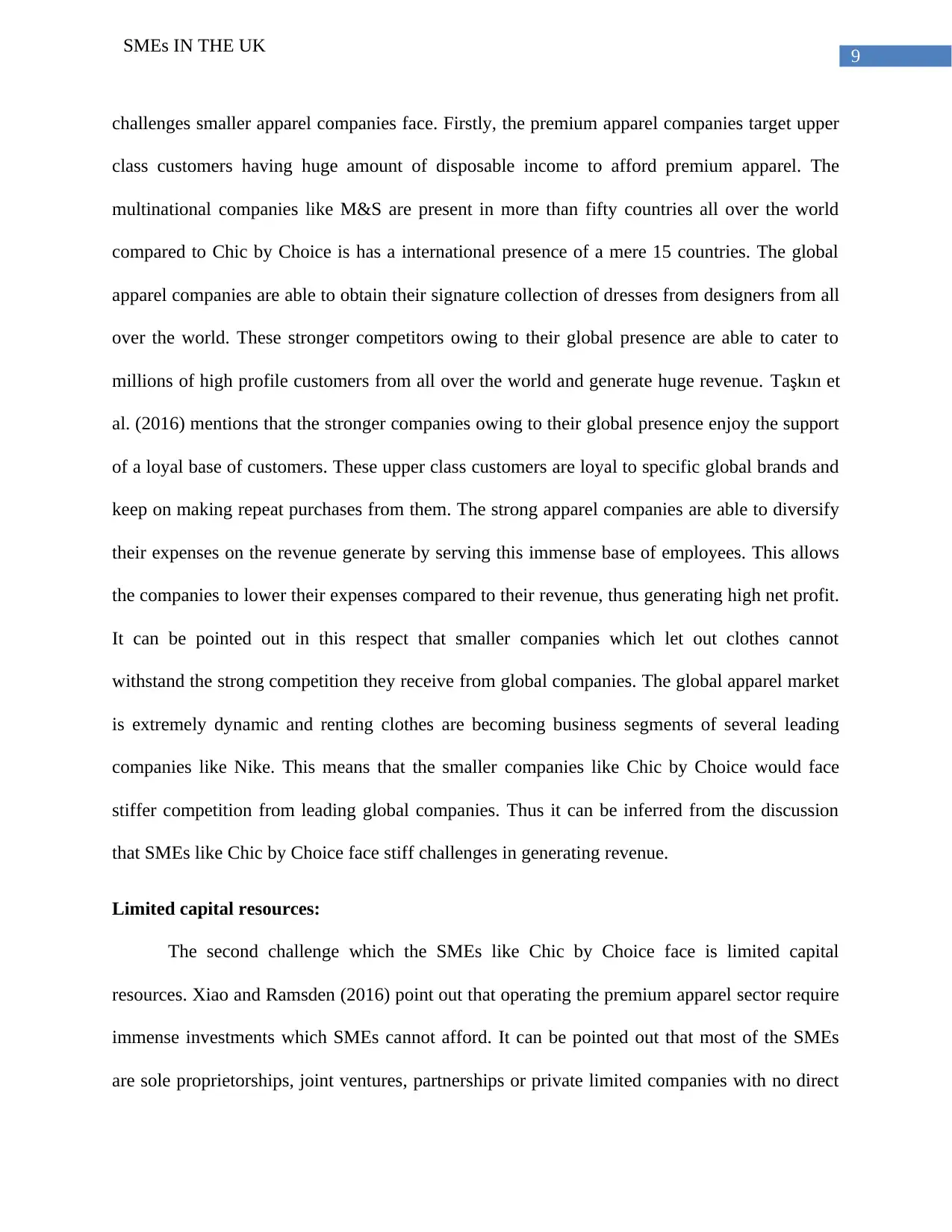
9
SMEs IN THE UK
challenges smaller apparel companies face. Firstly, the premium apparel companies target upper
class customers having huge amount of disposable income to afford premium apparel. The
multinational companies like M&S are present in more than fifty countries all over the world
compared to Chic by Choice is has a international presence of a mere 15 countries. The global
apparel companies are able to obtain their signature collection of dresses from designers from all
over the world. These stronger competitors owing to their global presence are able to cater to
millions of high profile customers from all over the world and generate huge revenue. Taşkın et
al. (2016) mentions that the stronger companies owing to their global presence enjoy the support
of a loyal base of customers. These upper class customers are loyal to specific global brands and
keep on making repeat purchases from them. The strong apparel companies are able to diversify
their expenses on the revenue generate by serving this immense base of employees. This allows
the companies to lower their expenses compared to their revenue, thus generating high net profit.
It can be pointed out in this respect that smaller companies which let out clothes cannot
withstand the strong competition they receive from global companies. The global apparel market
is extremely dynamic and renting clothes are becoming business segments of several leading
companies like Nike. This means that the smaller companies like Chic by Choice would face
stiffer competition from leading global companies. Thus it can be inferred from the discussion
that SMEs like Chic by Choice face stiff challenges in generating revenue.
Limited capital resources:
The second challenge which the SMEs like Chic by Choice face is limited capital
resources. Xiao and Ramsden (2016) point out that operating the premium apparel sector require
immense investments which SMEs cannot afford. It can be pointed out that most of the SMEs
are sole proprietorships, joint ventures, partnerships or private limited companies with no direct
SMEs IN THE UK
challenges smaller apparel companies face. Firstly, the premium apparel companies target upper
class customers having huge amount of disposable income to afford premium apparel. The
multinational companies like M&S are present in more than fifty countries all over the world
compared to Chic by Choice is has a international presence of a mere 15 countries. The global
apparel companies are able to obtain their signature collection of dresses from designers from all
over the world. These stronger competitors owing to their global presence are able to cater to
millions of high profile customers from all over the world and generate huge revenue. Taşkın et
al. (2016) mentions that the stronger companies owing to their global presence enjoy the support
of a loyal base of customers. These upper class customers are loyal to specific global brands and
keep on making repeat purchases from them. The strong apparel companies are able to diversify
their expenses on the revenue generate by serving this immense base of employees. This allows
the companies to lower their expenses compared to their revenue, thus generating high net profit.
It can be pointed out in this respect that smaller companies which let out clothes cannot
withstand the strong competition they receive from global companies. The global apparel market
is extremely dynamic and renting clothes are becoming business segments of several leading
companies like Nike. This means that the smaller companies like Chic by Choice would face
stiffer competition from leading global companies. Thus it can be inferred from the discussion
that SMEs like Chic by Choice face stiff challenges in generating revenue.
Limited capital resources:
The second challenge which the SMEs like Chic by Choice face is limited capital
resources. Xiao and Ramsden (2016) point out that operating the premium apparel sector require
immense investments which SMEs cannot afford. It can be pointed out that most of the SMEs
are sole proprietorships, joint ventures, partnerships or private limited companies with no direct
Paraphrase This Document
Need a fresh take? Get an instant paraphrase of this document with our AI Paraphraser
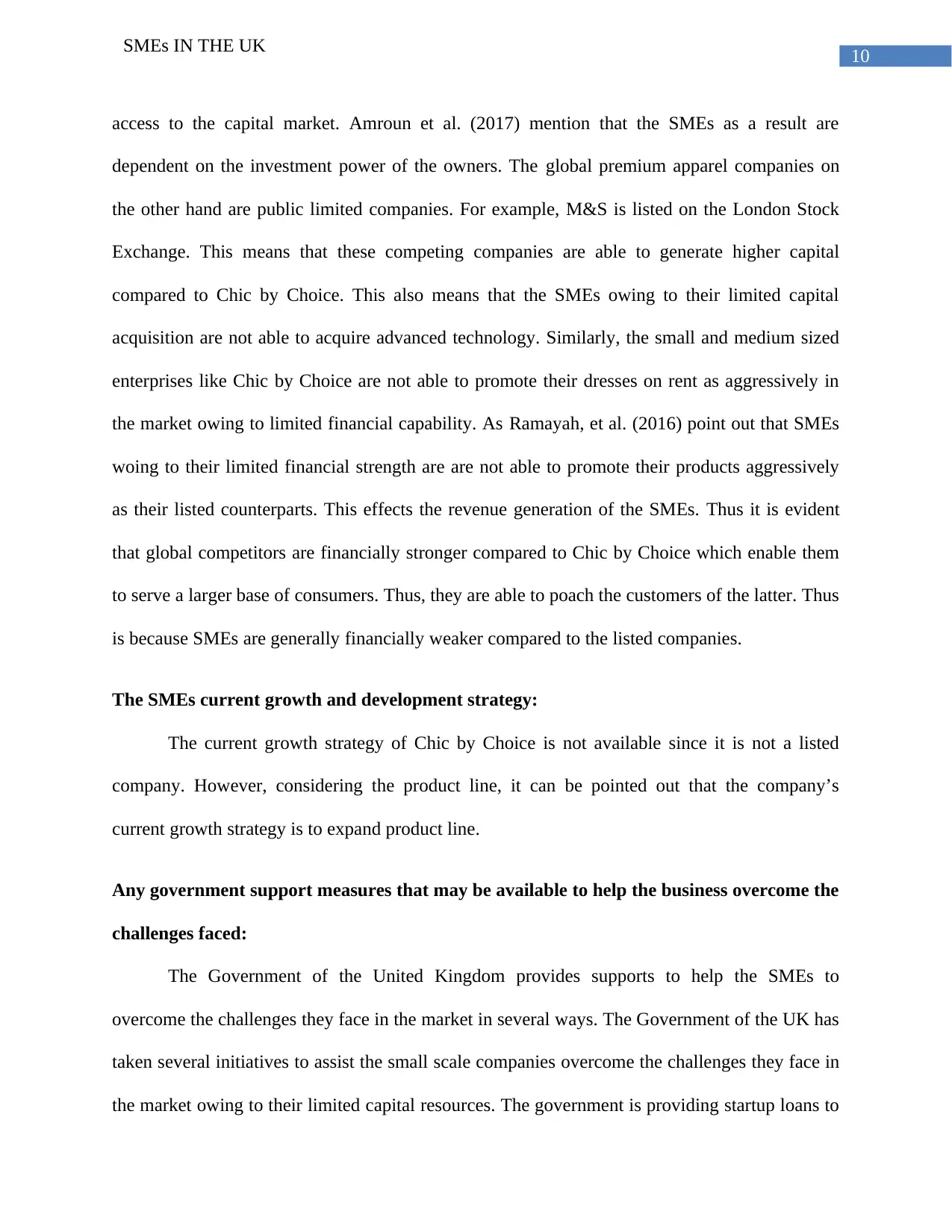
10
SMEs IN THE UK
access to the capital market. Amroun et al. (2017) mention that the SMEs as a result are
dependent on the investment power of the owners. The global premium apparel companies on
the other hand are public limited companies. For example, M&S is listed on the London Stock
Exchange. This means that these competing companies are able to generate higher capital
compared to Chic by Choice. This also means that the SMEs owing to their limited capital
acquisition are not able to acquire advanced technology. Similarly, the small and medium sized
enterprises like Chic by Choice are not able to promote their dresses on rent as aggressively in
the market owing to limited financial capability. As Ramayah, et al. (2016) point out that SMEs
woing to their limited financial strength are are not able to promote their products aggressively
as their listed counterparts. This effects the revenue generation of the SMEs. Thus it is evident
that global competitors are financially stronger compared to Chic by Choice which enable them
to serve a larger base of consumers. Thus, they are able to poach the customers of the latter. Thus
is because SMEs are generally financially weaker compared to the listed companies.
The SMEs current growth and development strategy:
The current growth strategy of Chic by Choice is not available since it is not a listed
company. However, considering the product line, it can be pointed out that the company’s
current growth strategy is to expand product line.
Any government support measures that may be available to help the business overcome the
challenges faced:
The Government of the United Kingdom provides supports to help the SMEs to
overcome the challenges they face in the market in several ways. The Government of the UK has
taken several initiatives to assist the small scale companies overcome the challenges they face in
the market owing to their limited capital resources. The government is providing startup loans to
SMEs IN THE UK
access to the capital market. Amroun et al. (2017) mention that the SMEs as a result are
dependent on the investment power of the owners. The global premium apparel companies on
the other hand are public limited companies. For example, M&S is listed on the London Stock
Exchange. This means that these competing companies are able to generate higher capital
compared to Chic by Choice. This also means that the SMEs owing to their limited capital
acquisition are not able to acquire advanced technology. Similarly, the small and medium sized
enterprises like Chic by Choice are not able to promote their dresses on rent as aggressively in
the market owing to limited financial capability. As Ramayah, et al. (2016) point out that SMEs
woing to their limited financial strength are are not able to promote their products aggressively
as their listed counterparts. This effects the revenue generation of the SMEs. Thus it is evident
that global competitors are financially stronger compared to Chic by Choice which enable them
to serve a larger base of consumers. Thus, they are able to poach the customers of the latter. Thus
is because SMEs are generally financially weaker compared to the listed companies.
The SMEs current growth and development strategy:
The current growth strategy of Chic by Choice is not available since it is not a listed
company. However, considering the product line, it can be pointed out that the company’s
current growth strategy is to expand product line.
Any government support measures that may be available to help the business overcome the
challenges faced:
The Government of the United Kingdom provides supports to help the SMEs to
overcome the challenges they face in the market in several ways. The Government of the UK has
taken several initiatives to assist the small scale companies overcome the challenges they face in
the market owing to their limited capital resources. The government is providing startup loans to
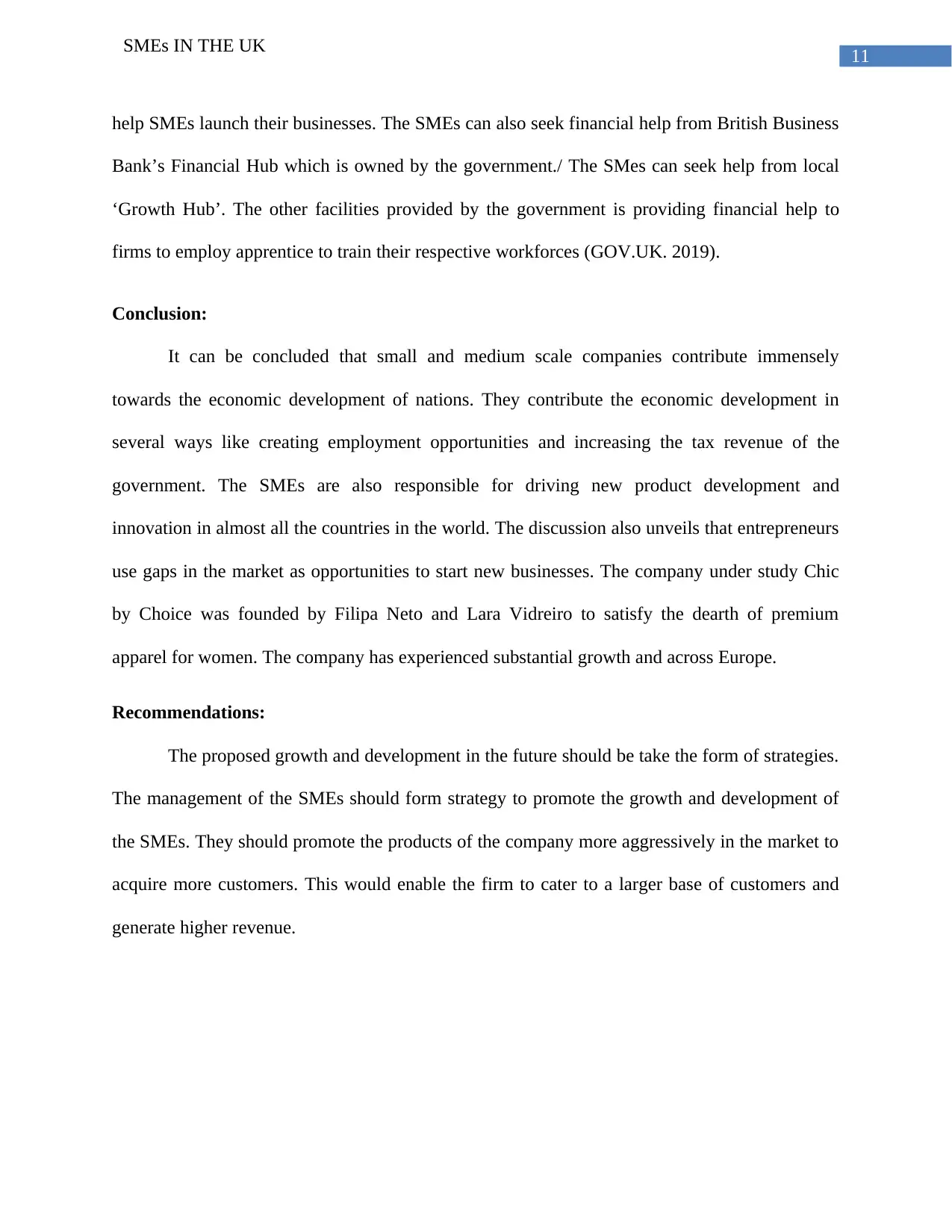
11
SMEs IN THE UK
help SMEs launch their businesses. The SMEs can also seek financial help from British Business
Bank’s Financial Hub which is owned by the government./ The SMes can seek help from local
‘Growth Hub’. The other facilities provided by the government is providing financial help to
firms to employ apprentice to train their respective workforces (GOV.UK. 2019).
Conclusion:
It can be concluded that small and medium scale companies contribute immensely
towards the economic development of nations. They contribute the economic development in
several ways like creating employment opportunities and increasing the tax revenue of the
government. The SMEs are also responsible for driving new product development and
innovation in almost all the countries in the world. The discussion also unveils that entrepreneurs
use gaps in the market as opportunities to start new businesses. The company under study Chic
by Choice was founded by Filipa Neto and Lara Vidreiro to satisfy the dearth of premium
apparel for women. The company has experienced substantial growth and across Europe.
Recommendations:
The proposed growth and development in the future should be take the form of strategies.
The management of the SMEs should form strategy to promote the growth and development of
the SMEs. They should promote the products of the company more aggressively in the market to
acquire more customers. This would enable the firm to cater to a larger base of customers and
generate higher revenue.
SMEs IN THE UK
help SMEs launch their businesses. The SMEs can also seek financial help from British Business
Bank’s Financial Hub which is owned by the government./ The SMes can seek help from local
‘Growth Hub’. The other facilities provided by the government is providing financial help to
firms to employ apprentice to train their respective workforces (GOV.UK. 2019).
Conclusion:
It can be concluded that small and medium scale companies contribute immensely
towards the economic development of nations. They contribute the economic development in
several ways like creating employment opportunities and increasing the tax revenue of the
government. The SMEs are also responsible for driving new product development and
innovation in almost all the countries in the world. The discussion also unveils that entrepreneurs
use gaps in the market as opportunities to start new businesses. The company under study Chic
by Choice was founded by Filipa Neto and Lara Vidreiro to satisfy the dearth of premium
apparel for women. The company has experienced substantial growth and across Europe.
Recommendations:
The proposed growth and development in the future should be take the form of strategies.
The management of the SMEs should form strategy to promote the growth and development of
the SMEs. They should promote the products of the company more aggressively in the market to
acquire more customers. This would enable the firm to cater to a larger base of customers and
generate higher revenue.
⊘ This is a preview!⊘
Do you want full access?
Subscribe today to unlock all pages.

Trusted by 1+ million students worldwide
1 out of 15
Related Documents
Your All-in-One AI-Powered Toolkit for Academic Success.
+13062052269
info@desklib.com
Available 24*7 on WhatsApp / Email
![[object Object]](/_next/static/media/star-bottom.7253800d.svg)
Unlock your academic potential
Copyright © 2020–2025 A2Z Services. All Rights Reserved. Developed and managed by ZUCOL.




